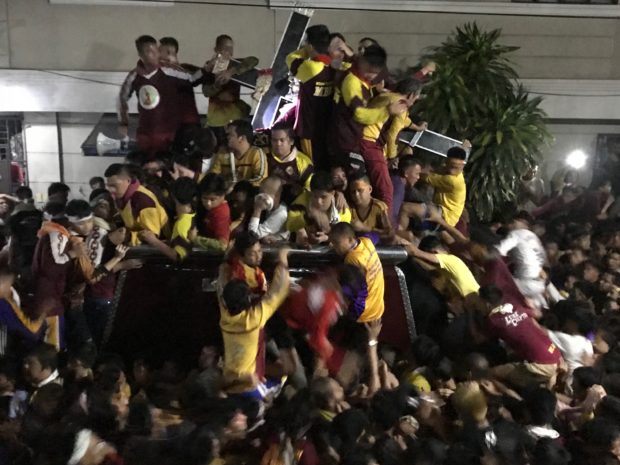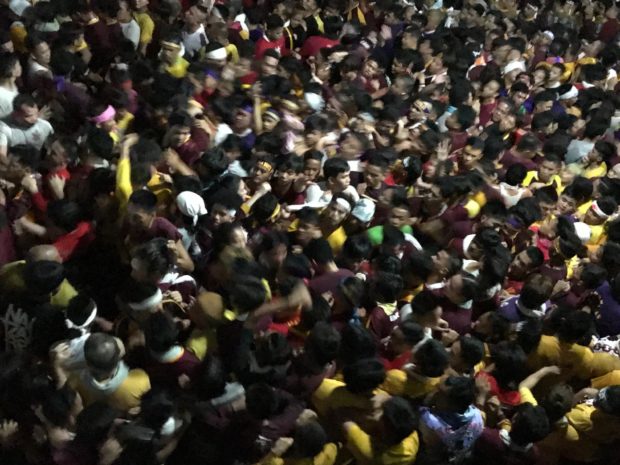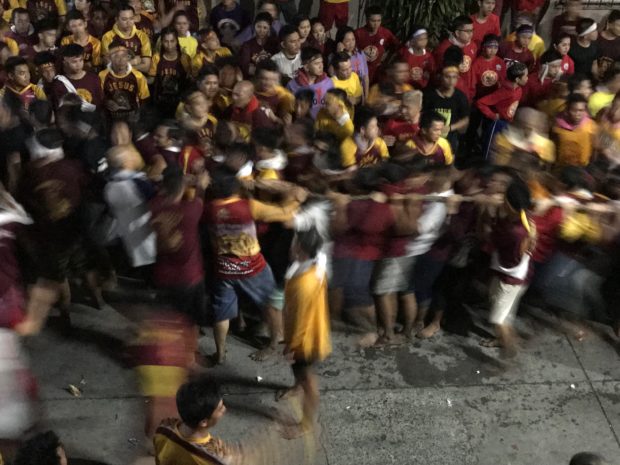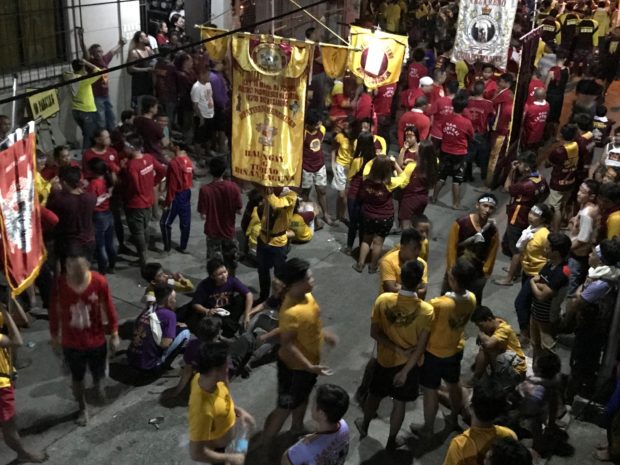Black Nazarene procession: A story of faith and struggle
MANILA, Philippines — A man, carrying his son on his back, was seen walking with thousands of devotees in one of the streets in Quiapo, Manila in the early hours of Good Friday, making his way towards the image of the Black Nazarene.
Other devotees assisted him as he struggled to approach the carriage of the Black Nazarene. A few steps before he reached the carriage, he already motioned to the hijos, or officials from Quiapo Church tasked to protect the image, to assist his child.
And upon reaching the carriage, he handed over the child to the officials.
The child then wiped the Black Nazarene with a towel. Church officials assisted the child to prevent him from falling. Before he went down the carriage, the child kissed the cross.
Among believers, the image and the cross bring miracles, so kissing the cross and touching the image are the ultimate goals.
Article continues after this advertisementHundreds of devotees flock to Vergara Street for the annual procession of the Black Nazarene during the Holy Week, carrying their prayers and their wishes. They also try to touch the rope and hold on to it as long as possible.
Article continues after this advertisementFriday’s procession was the second time the image of the Nazarene went out of the Minor Basilica of the Black Nazarene this year. The carriage leaves its home only thrice a year — during its Feast Day on January 9, on Good Friday, and during the thanksgiving procession every end of the year.
The procession during the Holy Week was no different from the January procession. Thousands of devotees from different parts of the country gather in Quiapo to touch the cross of the Nazarene, or to hold the rope that carries it at least.
The Black Nazarene, a statue of Jesus Christ that depicts his struggle to carry the cross on the way to Calvary, draws a lot of Filipino Catholics who believe that it brings miracles.
Data from the Manila Police District show that an estimated 35,000 devotees joined the procession that started at midnight on Friday.
READ: Around 35K devotees join Black Nazarene procession on Good Friday
Before the image reached Vergara Street, hundreds of devotees were already seen resting by the roadsides. Most devotees waited for at least an hour to get a glimpse of the Nazarene.
Getting near the image has always been a struggle for everyone. But the devotees find strength in their faith. It’s a struggle for the hijos, too, as they need to stop the devotees from climbing the carriage all through the procession while making sure that no one would get hurt.
In this year’s procession, the carriage of the Black Nazarene reached Fraternal Street around 1:30 a.m. However, it took some time for the carriage to turn to Vergara street. It was already past 2 a.m. when the tip of the rope was seen at the corner of Vergara.
Devotees tried to hold the rope and tried their best to hold on. But given the packed crowd and the number of people who want to get near the image, it wasn’t easy. Once they get hold of the rope, they say their prayers and wishes for the Nazarene.
Every time the carriage passes by a house, the hijos would ask for water from people watching from their terraces or windows. Unfortunately, most of the time, the have nothing to give but apologies and prayers.
There are two sets of devotees that help move the carriage: the devotees pulling the rope and the devotees pushing the carriage. The latter is located behind the image of the Black
Nazarene. They are the ones waiting for the signal of the hijos when to push. Their signal was a whistle. Once given the signal, they start pushing the carriage. This helps lighten the load of those pulling the rope in front.
The Good Friday procession may not be as intense as the January 9 procession, but the faith of the devotees are as fierce. It may not have fireworks display to signal the end of the procession like the Traslacion, and Quiapo residents may not have a feast ready, but one thing is sure: the public devotion for the Black Nazarene never changes.
Some people may mock those who participate in the procession, but these devotees don’t care about what other people say. What’s important for them is their faith.
The rope carries the prayers and secrets why the devotees try their best to hold on to it.
The image, meanwhile, gives hope to everyone, even those just watching from their houses that their wishes and prayers may be fulfilled. These two things will always remain as the image of the Quiapo Church. /ee



